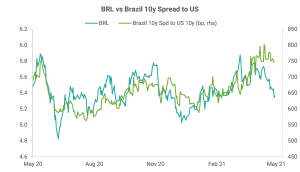Resumo do Relatório
Rates 10y Dashboard: Brazil Rates Lag the Currency’s Rally
US yields dropped following Fed Chair Powell’s press conference yesterday as he pushed back against the taper talk and emphasized that the upcoming rise in inflation readings should be transitory. However, the relief did not last long as the US 10y yield rose 3 bp to 1.65% this morning, reaching the highest level in two weeks.
EM 10y rates were also broadly higher as they moved up 2 bp on average. Poland 10y (PLN 10y), Brazil 10y (BRL 10y), and Chile 10y (CLP 10y) were all up around 10 bp each.
In the case of Brazil, rates have underperformed the recent rally in the real (BRL) as the chart below shows. We had written in a note in early March that the risk premia had gone up across the board in Brazil as the currency was moving in sync with rates at the time. Now, however, the correlation between the two has dropped.
The real has rallied for a few reasons:
- The central bank (BCB) started its tightening cycle in March with an aggressive rate hike of 75 bp and indicated that another similar hike was forthcoming at the May 5th meeting.
- President Bolsonaro reached a budget deal with Congress, breaking the previous impasse, as they agreed to exclude pandemic-related expenditures from the fiscal rules.
- The central bank has continued to actively intervene in the currency market despite the recovery.
- Rising commodity prices are supportive of the current account balance.
At first glance, the above reasons appear to justify the outperformance of the currency against rates since the budget agreement is positive for near-term growth, which is supportive of the currency, and high fiscal deficits should keep long-end rates high. However, this would be true if the currency and long-end rates were at equilibrium levels. Instead, they were at extreme levels with high risk premia priced in both. As such, any reprieve should have supported both in a similar fashion at least in the early leg of the rally.
As such, if the rally in the real is sustained, then long-end rates appear cheap in comparison. However, an outright long position in rates, or even in the currency for that matter, is risky for several reasons:
- Going into the presidential election next year, political noise is likely to rise and volatility across assets is likely to be elevated. Indeed, Brazil’s Senate has launched an inquiry this week into the government’s handling of the pandemic.
- The government has indeed bungled its response to the pandemic, prolonging the pain and keeping economic uncertainty high. Even the vaccination rollout has been a mess with the government cutting by 30% the number of vaccines to be delivered by April.
- With the election in mind, President Bolsonaro is likely to pursue populist policies which with the budget agreement increases the incentive to classify different types of expenditures to be related to the pandemic, thus exacerbating the fiscal crisis.
- While the central bank is due to raise rates at the next meeting, the curve is pricing in over 300 bp of further rate hikes by the end of the year. Inflation expectations for 2021 in BCB’s Focus Survey have now risen above 5%; this is above 4.6% in the same survey at the time of the last BCB meeting, and is considerably above the 3.75% year-end target, though just within the upper end of the target band. Any indication from the central bank that it may underdeliver on the hikes would result in a sell-off across assets, particularly the currency.
Given these risks, a better approach may be to go long rates hedged with the currency. In other words, we expect the relationship between the two assets to reassert to their prior correlation.

Data Source: Refinitiv
Best Longs / Best Shorts
- To our list of underperformers in the attached Rates 10y Dashboard pdf, we added CLP 10y following the sell-off today.
- The list already had Peru 10y (PEN 10y), Poland 10y (PLN 10y), and Mexico 10y (MXN 10y) on it.
- Our list of outperformers is currently empty.
Best Crosses
- Our list of preferred relative-value trades stayed unchanged with Receive PEN 10y vs Pay Indonesia 10y (IDR 10y) or India 10y (INR 10y) or Taiwan 10y (TWD 10y).
- The 3m expected returns for the pairs are in the range of 10-11% (not annualized), assuming mean reversion.
Aviso legal
DISCLAIMER: Este Relatório de Análise foi elaborado e distribuído pelo Analista, signatário unicamente para uso do destinatário original, de acordo com todas as exigências previstas na Resolução CVM nº 20 de 26 de fevereiro de 2021 e tem como objetivo fornecer informações que possam auxiliar o investidor a tomar sua própria decisão de investimento, não constituindo qualquer tipo de oferta ou solicitação de compra e/ou venda de qualquer produto. As decisões de investimentos e estratégias financeiras devem ser realizadas pelo próprio leitor, os Analistas, ou a OHMRESEARCH não se responsabilizam por elas. Os produtos apresentados neste relatório podem não ser adequados para todos os tipos de investidores. Antes de qualquer decisão de investimentos, os investidores deverão realizar o processo de suitability no agente de distribuição de sua confiança e confirmar se os produtos apresentados são indicados para o seu perfil de investidor. A rentabilidade de produtos financeiros pode apresentar variações e seu preço ou valor pode aumentar ou diminuir num curto espaço de tempo. Os desempenhos anteriores não são necessariamente indicativos de resultados futuros. A rentabilidade divulgada não é líquida de impostos. As informações presentes neste material são baseadas em simulações e os resultados reais poderão ser significativamente diferentes.
O(s) signatário(s) deste relatório declara(m) que as recomendações refletem única e exclusivamente suas análises e opiniões pessoais, que foram produzidas de forma totalmente independente e que a OHMRESEARCH não tem qualquer gerência sobre este conteúdo. As opiniões aqui expressas estão sujeitas a modificações sem aviso prévio em decorrência de alterações nas condições de mercado. O Analista responsável pelo conteúdo deste relatório e pelo cumprimento da Resolução CVM nº 20/21 está indicado acima, sendo que, caso constem a indicação de mais um analista no relatório, o responsável será o primeiro analista credenciado a ser mencionado no relatório. Os analistas cadastrados na OHMRESEARCH estão obrigados ao cumprimento de todas as regras previstas no Código de Conduta da APIMEC para o Analista de Valores Mobiliários e no Manual de Controles Internos para Elaboração e Publicação de Relatórios da OHMRESEARCH. De acordo com o art. 21 da Resolução CVM nº 20/21 caso o Analista esteja em situação que possa afetar a imparcialidade do relatório ou que configure ou possa configurar conflito de interesse, este fato deverá estar explicitado no campo “Conflitos de Interesse” deste relatório.
O conteúdo deste relatório é de propriedade única do Analista signatário e não pode ser copiado, reproduzido ou distribuído, no todo ou em parte, a terceiros, sem prévia e expressa autorização deste Analista. Todas as informações utilizadas neste documento foram redigidas com base em informações públicas, de fontes consideradas fidedignas. Embora tenham sido tomadas todas as medidas razoáveis para assegurar que as informações aqui contidas não são incertas ou equívocas no momento de sua publicação, o Analista não responde pela veracidade das informações do conteúdo.
Para maiores informações, pode-se ler a Resolução CVM nº 20/21 e o Código de Conduta da APIMEC para o Analista de Valores Mobiliários. Este relatório é destinado exclusivamente ao assinante da OHMRESEARCH que o contratou. A sua reprodução ou distribuição não autorizada, sob qualquer forma, no todo ou em parte, implicará em sanções cíveis e criminais cabíveis, incluindo a obrigação de reparação de todas as perdas e danos causados, nos termos da Lei nº 9.610/98 e de outras aplicáveis.





